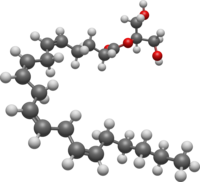
Photo from wikipedia
Endocannabinoids and endocannabinoid-related compounds (ERCs) are involved in many physiological processes. They are released on demand from phosphoinositide and N-acylphosphatidyl ethanolamine (NAPE) precursors and comprise 2-monoacylglycerols (2-MGs) and FA ethanolamides… Click to show full abstract
Endocannabinoids and endocannabinoid-related compounds (ERCs) are involved in many physiological processes. They are released on demand from phosphoinositide and N-acylphosphatidyl ethanolamine (NAPE) precursors and comprise 2-monoacylglycerols (2-MGs) and FA ethanolamides (FEAs). Despite the abundance of advanced quantitative methods, however, their determined concentrations in blood plasma are inconsistent because 2-MGs and FEAs undergo artifactual de novo formation, chemical isomerization, and degradation during sample collection and storage. For a comprehensive survey of these compounds in blood and plasma, we have developed and validated an ultra-HPLC-MS/MS method to quantify 24 endocannabinoids, ERCs, and their phospholipid precursors. Immediate acidification of EDTA-blood to pH 5.8 blocked artifactual FEA formation for at least 4 h on ice. The 2-MGs were stabilized after plasma harvest with 0.5 M potassium thiocyanate at pH 4.7. FEA and MG plasma concentrations in six healthy volunteers ranged between 0.04–3.48 and 0.63–6.18 ng/ml, respectively. Interestingly, only 1–5% of circulating FEAs were present in their free form, while the majority was bound to NAPEs. Similarly, 97% of 2-arachidonoylglycerol (2-AG) was bound to a potential phosphoinositide pool. The herein-described stabilization and extraction methods may now be used to reliably and comprehensively quantify endocannabinoids, ERCs, and their phospholipid precursors in clinical studies.
Journal Title: Journal of Lipid Research
Year Published: 2019
Link to full text (if available)
Share on Social Media: Sign Up to like & get
recommendations!